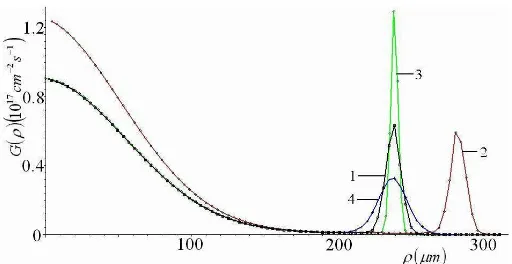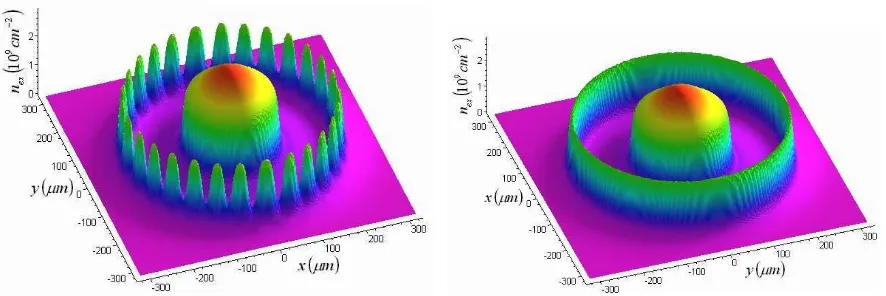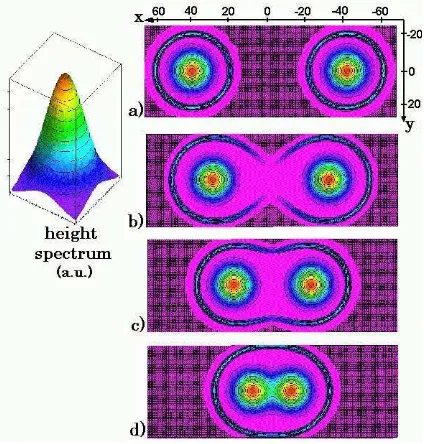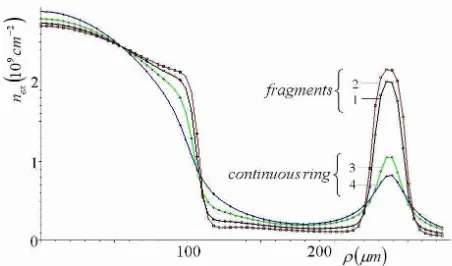Ordered Dissipative Structures in Exciton Systems
in Semiconductor Quantum Wells
Andrey A. CHERNYUK and Volodymyr I. SUGAKOV
Institute for Nuclear Research of NAS of Ukraine, 47 Nauky Ave., Kyiv, 03680 Ukraine E-mail: [email protected]
Received November 10, 2005, in final form February 08, 2006; Published online February 23, 2006 Original article is available athttp://www.emis.de/journals/SIGMA/2006/Paper025/
Abstract. A phenomenological theory of exciton condensation in conditions of inhomoge-neous excitation is proposed. The theory is applied to the study of the development of an exciton luminescence ring and the ring fragmentation at macroscopical distances from the central excitation spot in coupled quantum wells. The transition between the fragmented and the continuous ring is considered. With assumption of a defect in the structure, a pos-sibility of a localized island of the condensed phase in a fixed position is shown. Exciton density distribution is also analyzed in the case of two spatially separated spots of the laser excitation.
Key words: dissipative structures; exciton condensation; quantum wells
2000 Mathematics Subject Classification: 82C22; 82D37
1
Introduction
Indirect excitons in double quantum well (QW) structures consist of electrons and holes driven to the separate wells by an external electric field. They are long living particles due to the hampered electron-hole (e-h) recombination. The enhanced lifetime (more than 3 orders of magnitude longer than that of the direct excitons in single QWs) makes it possible to create large concentrations of excitons in order to study effects of the exciton-exciton interaction, an exciton condensation [1,2,3,4,5,6,7], in particular.
In AlGaAs and InGaAs based structures, a non-trivial feature in the photoluminescence spectra of excitons was observed [2,3,4,5,6,7]. A spot of the laser excitation was reported to be surrounded by a concentric bright ring separated from the laser spot by an annular dark intermediate region. The distance between the ring and the spot grew with increasing intensity of the pumping and reached up to hundreds µm exceeding by much the exciton diffusion path. In certain cases, an internal ring was observed nearby the laser spot.
At low temperatures (about 2 K), the external ring fragmented into a structure with a strongly evaluated periodicity on a macroscopic scale [2, 4, 6]. Fragments followed the external ring, even when the excitation spot moved on the sample area or when the ring radius varied with irradiation intensity. With temperature rising, the external ring disappeared.
Photoluminescence intensity of indirect excitons strongly grew in certain fixed spatial re-gions [2,4]. For any allocation of the excitation spot and its intensity, “localized bright spots” were observed, only when they were inside the area restricted by the external ring. These spots washed out with temperature growth.
roach papers [8, 9] suggested an explanation of the fragmentation of the ring by means of the nucleation of spots of a condensed phase. Models of phase transitions in a system of indirect excitons were studied in [10]. Finite lifetime of the excitons leads to the limitations on the size of the condensed phase areas, similarly to e-h droplets in bulk semiconductors. In a 2D system, these areas assume a shape of disk-like islands. The islands appear in the places of the highest exciton generation, i.e. on the ring. Due to the interaction between islands via the exciton concentration fields, there is a correlation in their positions eventually resulting in a periodicity.
The statistical approach suggested in [8,9] was based on the following assumptions:
1) the exciton generation rate on the ring is a smooth function of coordinates, and is almost constant within the region of a condensed phase island;
2) the distance between islands is much greater than the size of an individual island; 3) the boundary between the gas and the condensed phase is sharp.
In the present work we go beyond the stochastic approach of [8, 9] and remove the above assumptions and solve the problem phenomenologically. We have incorporated a term containing free energy of excitons into the equation controlling the exciton density. The resulting equation was solved with account of the pumping and finite lifetime of excitons. This approximation allows treatment of inhomogeneous systems and obtaining new results, for instance, description of transition from a fragmented to a continuous luminescence ring with changing parameters of the system, development of an internal ring in additions to the internal one, an explanation of localized spots in the emission, a deviation of the shape of fragments from the spherical, the excitation of the system by two laser spots. Study of these essentially inhomogeneous problems in the framework of the statistical model would be very complicated.
A mechanism leading to instability in exciton subsystem was suggested in the paper [11], yet the problem of the structures of the exciton density forms outside the laser spot at a non-uniform pumping was not considered.
2
The exciton generation rate on the ring
In order to determine the exciton generation rate, we use the model of the ring formation suggested in [6,7]. We shall obtain solutions for the cases, which will be applied in the further study of the fragmentation. The equations for the electron and hole densities in a QW plane outside the laser spot are
∂ne
∂t =De∆ne+Ke−W nenh−
ne−n0e
τe
, (1)
∂nh
∂t =Dh∆nh+Kh−W nenh− nh
τh
. (2)
ne (nh) is the electron (hole) concentration,De (Dh) is the electron (hole) diffusion coefficient,
Figure 1. The radial profile of the exciton generation rateG(ρ) in a QW plane. Pumpings are Ce =
1.5·1015
cm−1s−1, Ch = 3·1015cm−1s−1 for the curves 1, 3, 4 and 1.33 times larger for the curve 2. W is 3 cm2
s−1 for the curves 1 and 2; 22 cm2s−1 for the curve 3; 0.8 cm2s−1 for the curve 4.
well and the crystal outside, W is the e-h recombination rate, n0e is the electron concentration in the well in absence of the irradiation. Ke (Kh) is the electron (hole) creation rate, the radial profile of which is approximated by a Gaussian curve
Ke,h(ρ) =Ce,h
The exciton generation rate is proportional to the product ofne and nh:
G=qW nenh, (4)
where q is the share of recombined electrons and holes, which participate in exciton formation (q <1).
The system of the equations (1) and (2) was solved numerically on a disk or on a rectangular plate with the sizes considerably exceeding the ring radius. The task was solved with the following initial conditions: ne(r) = n0e, nh(r) = 0 at t = 0, and the boundary conditions:
The Fig. 1 shows the steady-state solutions of the equations (1) and (2). Radial distribution of the exciton density has a sharp maximum at a certain distance from the center. This maximum moves farther away from the laser spot with increasing the pumping (see curves 1, 2 in Fig. 1). Width of the peak depends on the e-h recombination rate W. This rate is determined by the tunneling processes and depends on the width of the barrier which separates the QWs in the double well structure. With increasing W, the peak does not change its position, but narrows down and grows in height (compare curves 1, 3, 4 in Fig. 1). Its integral value remains approximately, within several percent, constant.
3
Model of the system. Exciton density equation
M is the exciton mobility:
We chose free energy in the form suggested by the Landau model:
F[nex] =
Here, the termK(∇nex)2/2 characterizes the energy of an inhomogeneity. Free energy densityf is
ex are phenomenological parameters, which can be obtained from the quantum mechan-ical calculations, or extracted from the comparison of the theory with experiment.
After substituting equations (6) and (7) into equation (5), the latter becomes
∂ nex
for length, time and exciton concentration, respectively. We assume that equation (8) holds also if the condensed phase is an e-h liquid. Then F is a function of the density of e-h pairs.
The phenomenological equation (8) for study of periodical structures in exciton systems was employed in [12] for the case of spatially uniform exciton generation in bulk materials. In the case of infinite exciton lifetime (excitons are neither created nor decay), the above equation describes equilibrium states, i.e. two phases with the densities
n±ex =ncex±1 (9)
(in dimensionless units). The solution n−
Figure 2. Exciton densitynex(x, y) for the parameters corresponding to the generation rate given in
Fig. 1: a) for the curve 1, b) for the curve 3.
lifetime τex, the stationary uniform solutions of equation (9) are unstable. The exciton density varies in space periodically in the range limited by certain values nmin and nmax. In the case of the finite lifetime nmin and nmax can differ essentially from their equilibrium values. In the limit of the long exciton lifetimes (τex → ∞) nmin and nmax approach, respectively, their values in the gas n−
ex and the condensedn+ex phases.
In the given contribution the generation rate G is an essentially inhomogeneous function of coordinates. The system of the equations (1), (2), (8) is a closed system of the equations, which enables describing phase states in the exciton system under inhomogeneous excitation.
4
Numerical simulation of exciton condensed phase formation
on the ring
4.1 Exciton concentration distribution
Having determined the exciton generation rate by solving equation (4), we numerically studied the stationary solutions of the nonlinear Eq. (8) for the exciton density. We chose the following parameters of the system: Dex = 10 cm2s−1, τex = 10−7s, ξ = 4µm, τ = 3·10−9s, n0ex = 1.875·109cm−2
,nc
ex = 1.2n0ex,T = 2 K, β= 0.015. The simulation showed that for the exciton generation rate of equation (4) in Fig. 1, the excitons condense into a ring which can break down into separate fragments (see Fig. 2a). There were 28 and 36 islands on the rings of the radii 242µm and 295µm for the curves 1 and 2 of Fig. 1, respectively. An island shape is oval (of the order of 20µm×30µm at the half-maximum), which is determined by the parameter K.
Strictly speaking, in the system with strongly non-uniform density distribution, it is impos-sible to assign certain phase states to separate areas, nevertheless points of high density can be attributed to the condensed phase, and points of low density to the gas phase. Thus, the created fragments are periodically positioned islands of the condensed phase of excitons, emergence of which is caused by the finite value of lifetime and the inter-exciton attraction. The condensed phase comprised by a periodic array of exciton islands corresponds to the fragments observed in experiments [2,4,6].
The radius of the ring of the condensed phase grows in two cases: 1) with increasing the pumping;
2) if the laser spot expands leaving the integral intensity constant.
stated in the paper [13]. Additional investigations at different pumpings are needed for the final clarification of the inner ring formation.
As already specified, with increasing the e-h recombination rate W exciton generation rate becomes sharper (compare the curves 1 and 3 in Fig. 1). The results of the calculations show that with increasing W the fragmented ring of the condensed phase becomes continuous (see Fig. 2b). This is seen from the comparison of Figs. 2a and 2b, obtained for the different values of W (3 cm2s−1
and 22 cm2s−1
, respectively) and for the same values of other parameters. With decreasingK, the island size of condensed excitons diminishes, so the fragmented ring passes to continuous one. Increase ofK gives rise to continuous ring formation, because islands grow. The fragments do not form because the surface energy is smaller in the case of the cylindrical shape of a fragment. AsK is related with the surface energy, the role of the surface energy with K changing is not defining and the solid circle forms in the system.
The equation (8) can have solutions both as a continuous ring and as periodically placed islands of condensed excitons, and the choice of one of them can depend on the inhomogeneity of the system or on the boundary (initial) conditions.
4.2 Localized spots
The appearance of the “localized bright spots” can be attributed to non-uniformities of different nature in the QW [2, 4]. We have undertaken an attempt to simulate them in our approach, assuming that there is a certain region that differs from the surrounding regions by quality of the contact between the well and the matrix in which the wells are grown. We assumed that the value of τe, which characterizes the time of the establishment of the electron density equilibrium between the wells and the matrix, varies in space and expressed this non-uniformity in the vicinity of the point r0 = (L,0) as
τe(r) = τe
1 +Bexph−(x−L2c)22+y2
i. (10)
We carried out calculations of the exciton density profile governed by equation (8). An additional island located in the region of the non-uniformity emerges in this case (see Fig. 3). Obviously, in the case of several defects, several islands would appear as observed in [2, 4, 6]. This is a consequence of non-linearity of the system. So, inhomogeneity, which arises in the crystal as a result of technological processes, can be a nucleus of new fragments.
Similar calculations can be performed for inhomogeneities of a different nature. So, the presented theory can describe condensed states localized near defects.
4.3 Modelling of two spots excitation
Figure 3. Emergence of a localized spot in the exciton density distribution at a point of local non-uniformity given by equation (10) with parameters B= 150,L= 190µm,c= 12.2µm.
Figure 4. Exciton density distribution in the system irradiated by two laser spots. The distance between the spots centers are: a) 84µm, b) 61µm, c) 42µm, d) 21µm. The pumpings are smaller than in Fig. 2.
and (2) with two laser sources with the radial shape (3) each. Our calculations show non-linear contributions of the excitation from two spots: rings become extended in mutual directions and at a certain stage of spots approaching merge into a common oval-shaped ring (see Fig. 4). So, in such a way the rings can interact.
The results in Fig. 4 confirm the non-additive character of the rings interaction, observed in the experiment [3].
4.4 Behavior versus temperature
We studied [3] behavior of the system versus temperature. We assumed that the parameter a
(see equation (7)) can be represented according to the Landau model:
a=α(Tc−T),
Figure 5. The radial profile of the exciton densitynex(ρ) at different temperatures: 1) 2 K, 2) 1.6 K,
3) 2.7 K, 4) 4.4 K.Tc= 3.7 K. The curves 1 and 2 represent the fragmented ring, the curves 3 and 4 are
the profiles of low continuous rings.
5
Conclusions
Thus, the results of our study of the exciton condensation in a coupled QW around the laser spot can be summarized in the following conclusions:
1. Fragmentation of the external ring of exciton density occurs at a certain threshold value of the exciton generation rate (pumping).
2. Transition from a fragmented ring to a continuous one occurs at increased value of the electron-hole recombination rate (i.e. for a narrower barrier between the QWs), with re-duction of the surface energy (the parameterK) and at higher temperature.
3. In a QW with a macroscopic defect a localized island of the condensed phase may emerge inside the external ring.
4. Possibility of the development of an internal ring depends on the character of decrease of irradiation intensity at the edge of the laser spot.
5. Exciton luminescence rings caused by two spatially separated laser spots attract and even-tually form a common oval-shaped ring.
The considered periodical structures exist only due to the external excitation and are the development of self-organization in the system of exciton condensed phases. According to the classification of [14], structures of such type which exist exclusively in non-equilibrium conditions are called dissipative.
Acknowledgements
The work was supported by INTAS grant No.03-51-5266 and by the Ukrainian Ministry of Education and Science (project No.02.07/147). The authors thank to Dr. I.Yu. Goliney for useful discussions.
[1] Larionov A.V., Timofeev V.B., Condensation of interwell excitons in GaAs/AlGaAs double quantum wells, JETP Lett., 2001, V.73, N 6, 301–308.
[2] Butov L.V., Gossard A.C., Chemla D.S., Macroscopically ordered state in an exciton system,Nature, 2002,
V.418, 751–754; cond-mat/0204482.
[3] Snoke D., Denev S., Liu Y., Pfeiffer L., West K., Long-range transport in excitonic dark states in coupled
quantum wells,Nature, 2002, V.418, 754–757.
[4] Butov L.V., Exciton condensation in coupled quantum wells,Solid State Comm., 2003, V.127, 89–98.
[6] Butov L.V., Levitov V.B., Mintsev A.V., Simons B.D., Gossard A.C., Chemla D.S., Formation mechanism
and low-temperature instability of exciton rings, Phys. Rev. Lett., 2004, V.92, 117404, 4 pages;
cond-mat/0308117.
[7] Rapaport R., Chen G., Snoke D., Simon S.H., Pfeiffer L., West K., Liu Y., Denev S., Moving beyond
a simple model of luminescence rings in quantum well structures, Phys. Rev. Lett., 2004, V.92, 117405,
4 pages; cond-mat/0406141.
[8] Sugakov V.I., Formation of an order in a system of exciton condensed phase islands in quantum wells,Ukr. J. Phys., 2004, V.49, 1117–1121; cond-mat/0407398.
[9] Sugakov V.I., Islands of exciton condensed phases in a two dimensional system, the distribution of their sizes and coherence in position,Solid State Comm., 2005, V.134, 63–67.
[10] Lozovik Yu.E., Berman O.L., Phase transitions in the system of two bound quantum wells, JETP Lett.,
1996, V.64, 526–531.
[11] Levitov L.S., Simons B.D., Butov L.V., Pattern formation in exciton system near quantum degeneracy, cond-mat/0503628.
[12] Sugakov V.I., Instabilities and self-organization phenomena in high density exciton systems,Phase Transi-tions, 2002, V.75, 953–960.
[13] Ivanov A.L., Smallwood L.E., Hammack A.T., Yang S., Butov L.V., Gossardet A.C., Origin of the inner ring in photoluminescence patterns of quantum well excitons, cond-mat/0509097.



